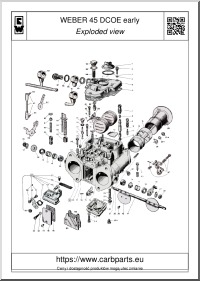Well, not exactly a barn find but found in a storage unit I was helping to clean out. I am not familiar with Weber DCOE carbs, I just have heard lots of interesting things (mostly good and some cautionary about tuning and matching them properly to the application); but I am about to be. Evidently the pair are made in Italy, but may be somewhat mismatched based on the stampings. I am looking for more identification information. I haven't even taken them out of the box, so an adventure is ahead. I currently have a nice pair of SU HS6 carbs that are working quite well, so I have plenty of time to get these sorted out, providing they are rebuildable. Hopefully, they just need cleaning and a new rebuild kit, etc.
![Image]()
Here is the mismatched (?) type info I'm confused about. One carb is stamped Type 45DCOE9 and Number 25364 and the other is Type 45 DCOE 15 and Number 3L.
![Image]()
![Image]()
![Image]()
Here is the mismatched (?) type info I'm confused about. One carb is stamped Type 45DCOE9 and Number 25364 and the other is Type 45 DCOE 15 and Number 3L.







